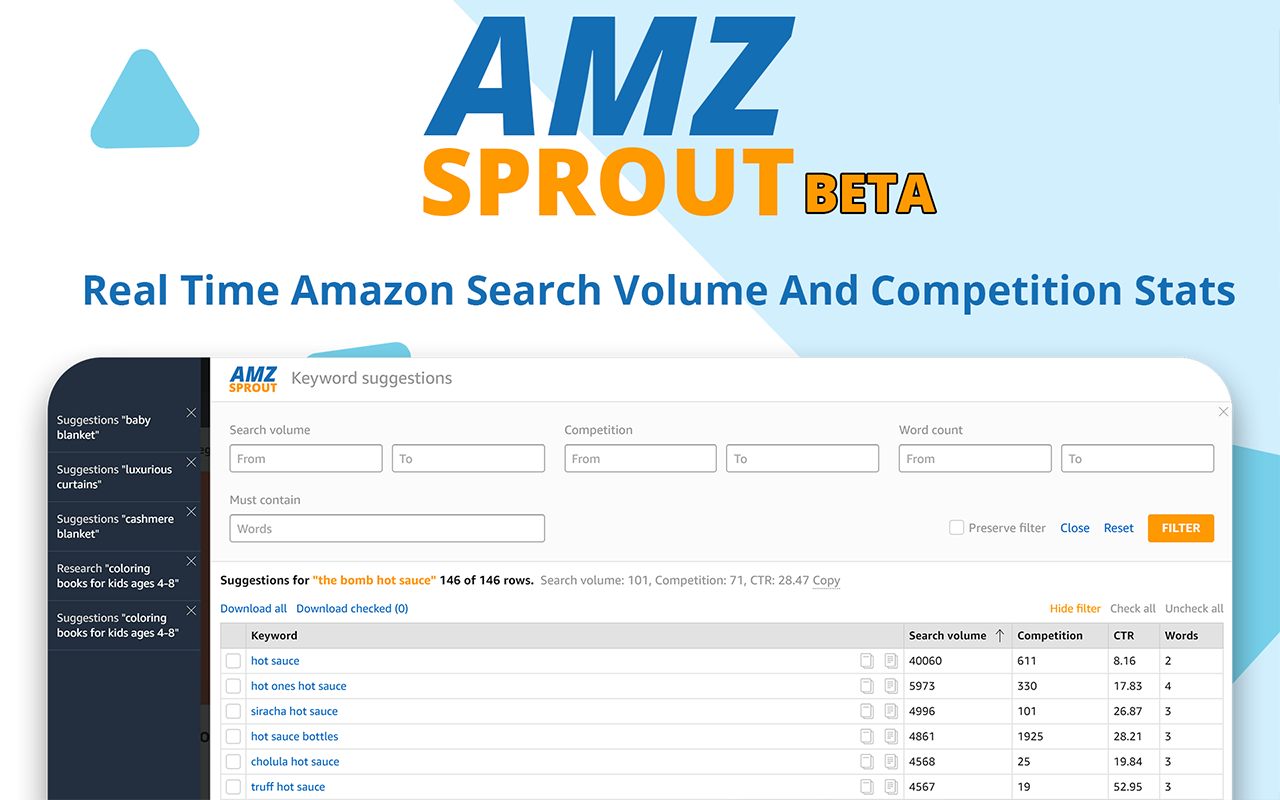
Amazon Keywords: How To Optimize Amazon Product Listings (Ultimate Guide)
When it comes to selling any type of product on Amazon, you need to be thinking about how to optimize for Amazon to get the buy box as well as move your product up the search results. After all, Amazon is a search engine and even if you have the best product in the world, it means nothing if you cannot get it in front of an audience of hungry buyers. The key to the entire puzzle involves algorithms designed to deliver searchers (Amazon shoppers) the best experience throughout the process.
So, let’s take a look at your Amazon keyword strategy, explain what you should be looking for, the different parts of an Amazon listing where keywords come into play, and how to optimize a product properly.
Throughout this article, you may notice different screenshots with keywords, competition, search volume and more. You will want to grab this free extension to follow along: AMZ Sprout
These will all influence how successful you are as an Amazon seller so let’s get to it!
Ranking Factors
Amazon’s search algorithm is referred to as A9, but after the past year and the different weighting that it gives to certain factors, people have started to refer to it as the Amazon A10 algorithm. If you go ahead and visit a9.com, surprise surprise, you are directed to Amazon.com. This algo is CRUCIAL to your success as an Amazon seller. Amazon stands as the biggest ecommerce website on the planet and they care about their bottom line above anything else (even though they always say customers first). Making sure you are an efficient seller is what will make you stand out.
As mentioned above, Amazon is a search engine. Whereas most search engines have queries that are informational in nature, almost every search conducted on Amazon is transactional. This means there are two major ranking factors that drive their algorithm:
- How relevant your product is
- Performance of your product
That’s it! If you can nail down your Amazon product page for these two ranking factors, you will convert more, sell more, and become a much bigger seller.
Let’s take a look at what this even means.
How Relevant Your Product Is
Chances are, if you are reading this, you already have a product ready to launch or already launched on Amazon. The good news is that you are able to influence these ranking factors simply by making sure you are using relevant keywords in different parts of your product listing.
Product Title – IMPORTANT
The title of your product is the most important part of any listing for Amazon SEO specifically because this is what the A9 algorithm is going to pick up first as far as relevance. You will want to put the most relevant keywords to your exact product in the title.
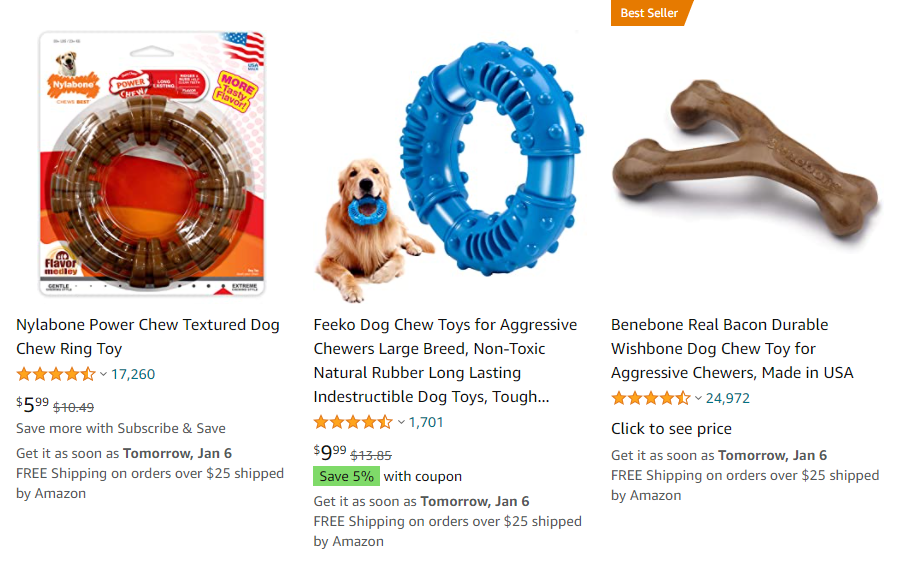
The top 3 results on Amazon for “dog chew toy” all have those words in the product title. This is relevance.
Just take a look at the search volume here and notice the keyword underlined in red (which one of the top sellers is also using!)

When it comes to the name of your Amazon product, here are some tips:
- If you are selling under a brand, include this in the title of your product
- Specify the size of the product you are selling
- Add a clear description in the title of what the product does and who/what it is for
- If applicable, mention the color/makeup of your product
The goal here is to fill out your title exactly the way a customer would look for it. Keyword stuffing should be avoided at all costs. Not only does keyword stuffing an Amazon listing look bad, but this will also heart your Amazon search rankings because of a worse customer experience. You want the title to read naturally when you speak it out loud. Anything else will have a negative impact on your click through rate and your product will fall down the rankings.
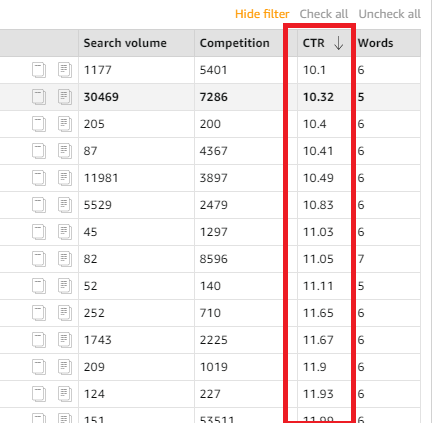
In order to find great product titles, run a search through AMZ Sprout for the main keyword and take a look at the Click Through Rates (CTR) for those keywords. Then, examine the best selling products on those pages. Notice how they are formatting their titles in order to get the highest click through? This is what you should model your title after.
Brand/Seller Name – Semi Important
Take a moment to think about the seller name or the brand of your product on Amazon. This has been seen as a relevance ranking factor in the past and currently. Sometimes, if you can get a keyword into your seller name or brand where it reads naturally, this will cause the product to rank higher on Amazon’s organic search results.
Let’s take a look at an example. If we go to Amazon and search for “funny dog shirts”, we see this example:
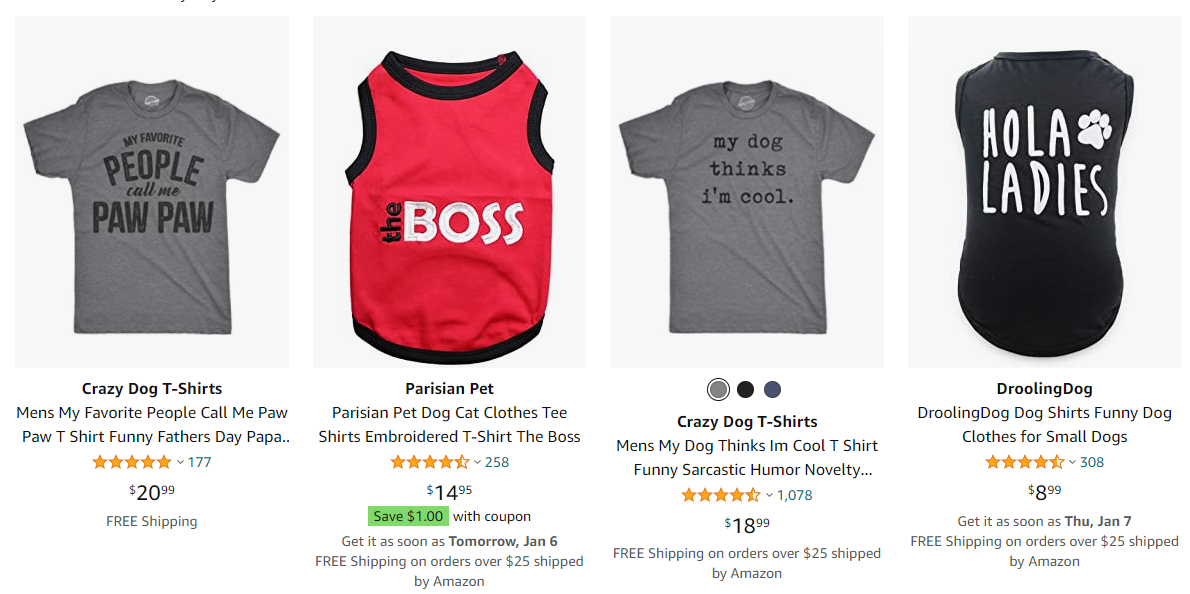
Notice the brands of the sellers that have listed these products? The word “dog” and “pet” in the seller name could be helping them rank higher in the results.
Pay close attention to the name and brand that sellers are selling under when doing your research.
Depending on what kind of product you are selling, picking out a related keyword to put in your brand could be useful. If we were going to list a product related to dog shirts, we may want to look at any of these to see if we could fit something in:
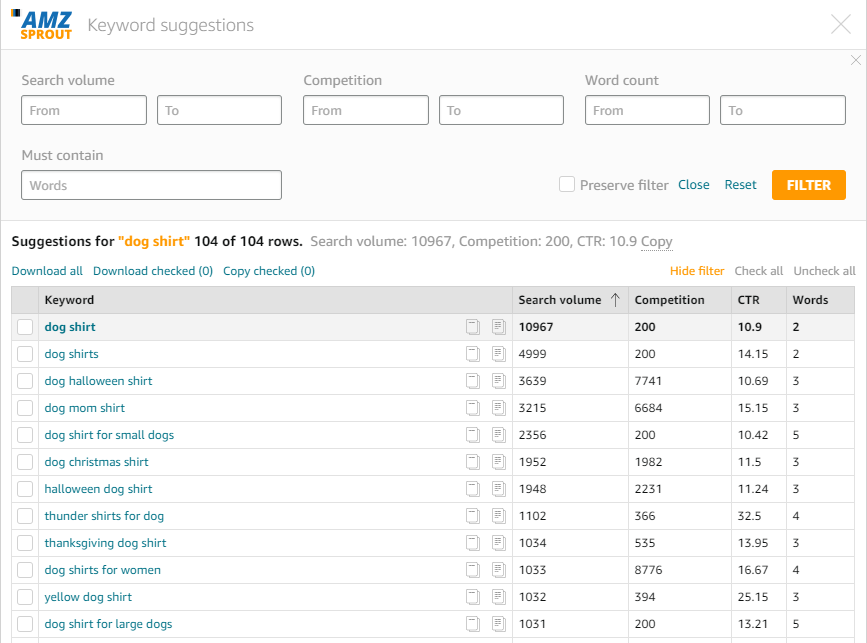
Amazon Backend Keywords – IMPORTANT
You may or may not have heard of Amazon backend keywords. What are those things anyway?
Backend keywords are really just “hidden” keywords that you can use in your listing through the backend of Amazon seller accounts. These keywords are not seen by the customers searching the page – but, are rather keywords you as a seller can enter in on the backend that will tell Amazon’s algorithm that a special listing is targeting particular keywords on their website.
Think of these as a way to tell Amazon what you SHOULD be ranking for, without making your customer facing listing look spammy. You are basically whispering in their ear that your product is relevant to X, Y, and Z, while not needing to put those onto the product listing page.
There are five different fields that sellers can fill out with different backend keywords. Currently, each line can hold 50 characters (and no more). If you go over this limit, those keywords in the backend will not be indexed by Amazon.
When filling these out, remember to keep them RELEVANT (because how relevant they are is going to ensure you rank highly). Other things to keep in mind:
- NO repeating of words
- Ignore punctuation (this includes commas, quotation marks, dashes, etc.)
- Don’t include many variations of the same word
- Focus on synonyms and variations in spelling if applicable
Your Amazon backend keywords and the keywords you chose to put in your title are some of the most important aspects to optimizing a listing for relevance.
One of the easiest ways to fill this backend keyword list up is to open up AMZ Sprout (that you could get from the link above FOR FREE), and then run a search based on the main keyword you are optimizing for. If for example you are optimizing for a dog collar for large dogs, there are a lot of great keywords you could include in the backend depending on how you set your product up:
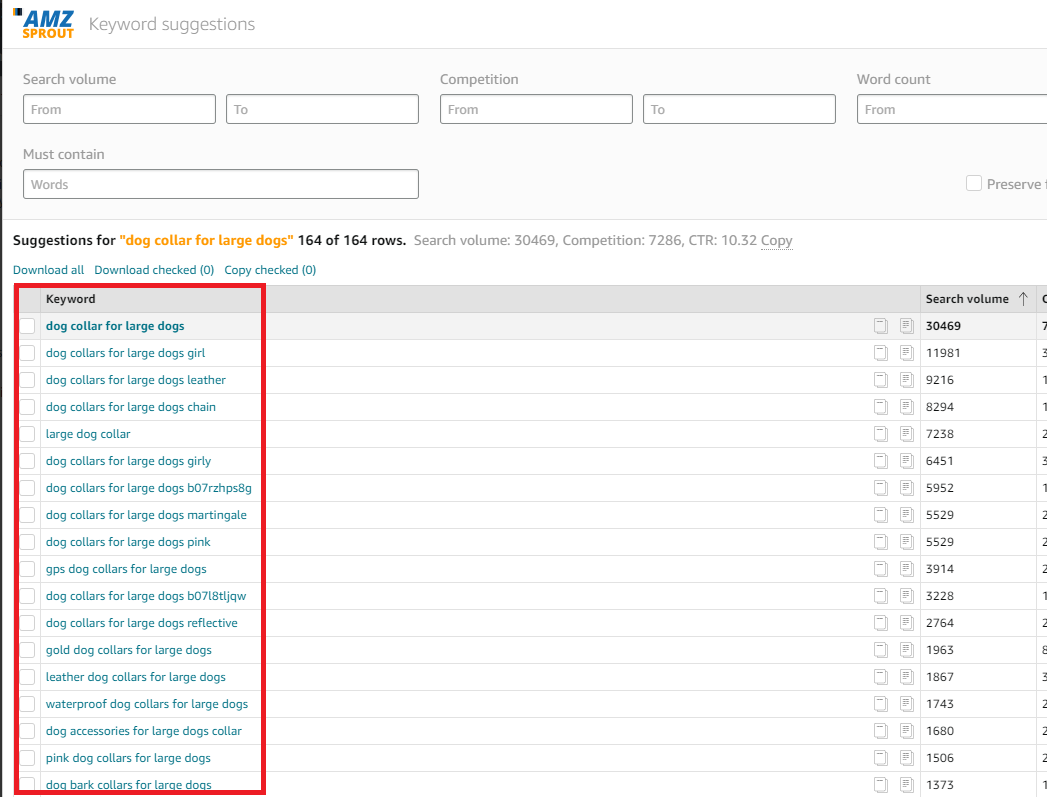
Product Key Features and Description – IMPORTANT
The key features for your product are a little bit different from the description, but they both go hand in hand. These will tell your customers on Amazon about the product so you can get very detailed as well as a bit “salesy” (tell them exactly why they should buy this product). You will want to include more detailed and relevant important keywords here as well!
Again, when creating your bullet points, make sure that you can read them out loud to yourself without a hang-up. This will ensure your bullets are detailed but also make sense to a customer when they are reading them.
For the description, you will want to make sure that the copy you are putting out is readable, and convincing. However, the description itself does not really help you rank on Amazon so you can forgo making sure this is optimized with the best keywords. Instead, focus your description from a sales standpoint to get them to buy the product.
What are the benefits of your product, what are the dimensions, is it made with any special ingredients? Add value to each part of the process but really hit home in the description.
The bullet points are where you want to focus the majority of your time here to add the keywords you want to rank for. After the title and backend keywords, this is the third most important keyword spot on Amazon.
Performance Of The Product
The performance of the product you are selling is a bit harder to have direct control over, but these are still some additional considerations beyond just the keywords.
HOWEVER, the keywords we talked about above DO relate to the overall performance and how your product does on Amazon.
Price
This is pretty much common sense, but how you price your product is going to have a massive impact over the Amazon conversion rate.
Think of the good old garlic press. If a seller listed their garlic press at $5,000 do you think it would convert at all? I highly doubt it. The pricing of your product will determine how many units you end up selling.
IF your price is competitive to other sellers and products, your conversion rate will be much higher than if you were not paying attention.
Look at the other products in the same category that you are currently selling. Are you priced higher than the average? Are you priced lower?
If you are priced higher, you may not sell as many units as other products. This means that Amazon’s algorithm will then realize that your product will not sell as well as the others and… not rank you as high (remember, Amazon cares about their bottom line!). They want products that fly off the shelves, not sit there and take up space.
You will suffer with a lower Amazon search ranking if you are not pricing appropriately. Don’t charge too much, and compare your product with other competitors on the site and see how they are doing.
Amazon Conversion Rate
This goes hand in hand with your product price. Your Amazon conversion rate is a big performance factor in your search rankings. If 100 people visited your product page, and 100 people purchased, Amazon will know that you have a product that converts better than every other seller and will reward you with a higher ranking (because it is flying off their shelves).
However, if you have 100 people looking at your listing and NO ONE purchases, the Amazon A9 algorithm knows your product is a dud and will not want to show it to anyone else because you are not converting.
You can take a look at the Seller Central detail sales page and traffic and then come to conclusions from there.
If your conversion rate is not great and you think your product should be doing a lot better, then you will want to go back to the beginning of this article and start looking at some of the relevance factors so see if you can optimize your listing to appear higher in Amazon search with better keyword usage.
Reviews
Reviews are social proof that your product is what it says it is, and customers like it. Seems pretty straight forward but this is also another performance related ranking factor in Amazon’s algorithm.
In fact, you probably know someone that shops strictly based on reviews. If it is not 4-5 stars, even if it is a great product, they want nothing to do with it.
You will notice when looking at the search results that the front page is filled with items that have lots of reviews. The more broad the keywords that are being used, the more reviews they typically have. This is why getting your keyword strategy right is crucial.
Just by thinking about it a bit, you can come up with the fact that having more reviews is going to have a positive impact on click through rates which will lead to more sales (if your Amazon product listing is optimized with good Amazon keywords).
You will want to make sure these are REAL reviews though, as Amazon has recently cracked down on fake reviews. The best way to get real reviews, is getting a good sales velocity (which means pricing competitively), – and having a great listing. The rest will come with time.
If you notice you are getting negative Amazon reviews, look at what people are saying so that you can focus your time and energy to address the problem with your product. Maybe the product itself is fine but the listing has something that is throwing them off. Learn from these reviews to improve your business.
Product Images
Finally, we have the product images. High quality images simply have a higher conversion rate on Amazon which is why it is crucial that you ensure you have them for your Amazon product page.
You will want to take a look at the seller central product image guidelines here.
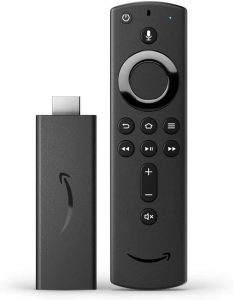
That being said, this is not going to be as big of an issue if you are selling on an Amazon platform like Kindle Direct Publishing or Merch by Amazon (as they take care of the product images for you). If you are not, you will want to focus some time and energy here, as this is what will catch the customer’s eye before they even read your title.
Free Amazon Keyword Tool
Now that we are nearing the end of this guide on Amazon keywords, you should understand how absolutely critical these are to your Amazon success.
This is exactly why we developed AMZ Sprout which is a FREE Chrome extension which you can get at the top of the page or by clicking this link right here:
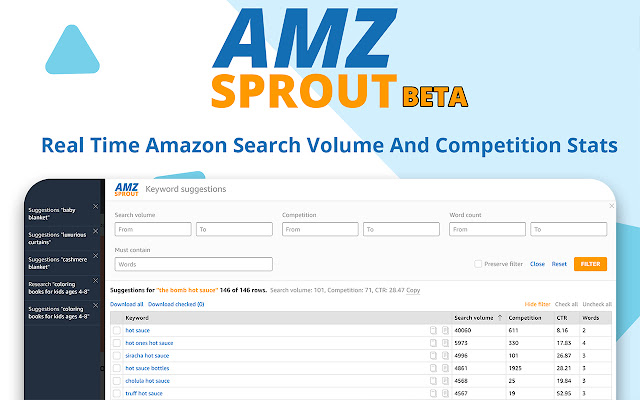
We created this tool because this is EXACTLY what we wished we had when we first started.
- Keywords that are relevant…check
- Search Volume so you can figure out if customers actually look for those keywords on Amazon…check
- Click Through Rate and Competition Data?….check
- Advanced Filters so you can find what keywords fit your parameters…check!
You will see above in each section some screenshots that come directly from this tool. Best of all, it is free!
If you have any questions about it, please make sure to drop us a comment down below.
Wrapping Up Amazon Keywords – Get To Work!
Successfully Amazon keyword strategies comes down to understanding exactly what the Amazon algorithm is looking for from you as a seller and then giving them exactly that. To boil it down to simple terms… they want you to make the customers happy and coming back for more!
Your product page has a lot of options for optimization and customization but remember that at the end of the day you want to focus on relevance and performance of your listing to get the best results.
If you make changes to your keyword strategy with these in mind, you should see movement in your Amazon search rankings, conversion rates, and end up growing your business faster than you ever thought possible.
Until next time, have fun selling and make sure to focus on the right keywords!
